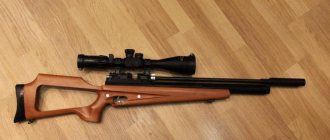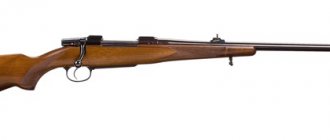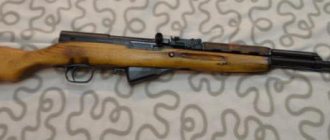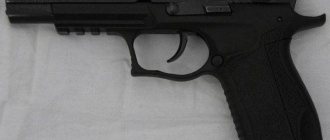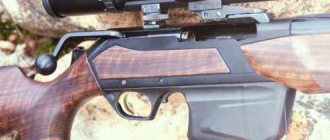At the end of last year, it announced the release of a new carbine VPO-223 . The new product was another attempt by domestic gunsmiths to adapt to Russian legislation - formally, the smoothbore carbine is equipped with a barrel with a Lancaster drill. By law, it is still considered a smoothbore gun, and five years of gun ownership experience is not required to purchase it.
We were able to not only inspect the new product, but also test it at the shooting range - in this article we will talk in detail about the results of shooting the VPO-223 carbine out of the box - without additional zeroing or adjustment. But first, let's remember what kind of beast this is - the VPO-223 carbine.
VPO-114 Jaeger carbine - owner reviews, technical specifications
A short comic on removing the front sight from the VPO-114.
We squeeze out the front sight, unscrew the screw, turn it and remove the base of the front sight, and what remains is this thing, I didn’t squeeze it out, sorry I didn’t have a press at hand. But I decided for myself that as soon as I find the dtk, I’ll stupidly cut this part off. The trigger mechanism is made as a separate part in a duralumin body, with the ability to adjust the stroke and force with two separate screws. It also houses a two-position safety lever with its own safety mechanics.
The carbine is equipped with two magazines for three rounds. The stores are made according to the “2-1” rebuilding scheme and the motto “in the old days they knew better”; the commandant’s office cannot think of any other justification for the use of a leaf spring.
The bolt is as powerful as a barrel, and the movement of the bolt after removal from preservation turned out to be surprisingly soft and smooth, not requiring any excessive effort. The shutter handle is located conveniently, you can catch it with your hand without looking, literally after three or four idle runs of the shutter.
By the way, the rifle is surprisingly handy and well balanced despite the heavy barrel; at least there was no “heaviness” felt after a dozen throws.
The location and movement of the fuse does not cause discomfort, as does its operation. Changing the magazine is somewhat unusual, due to two latches located on the sides.
I contacted the company store in Moscow with this problem and asked to sand the cracker a little. The master looked and said that it was not necessary. They showed me a store for a huntsman with an influx along the front side, they told me to call in March, this should solve the problem.
I decided to start with polishing the USM. To do this, it must be disassembled.
First of all, I unscrewed the screw securing the fuse on the base of the trigger. There is a spring-loaded pin under the fuse that can fly out without being lost. Then I completely unscrewed the trigger pressure adjustment screw and pulled everything out of the spring-loaded channel along with the peg. Then I used a hammer to knock out the axis of the trigger and the sear; the sear is spring-loaded; do not lose the spring and the pin.
The axles sit loosely in the aluminum base, so during assembly they must be fixed either with a drop of varnish or with thread locker. We have a pair of sear-hooks in our hands.
First of all, I sanded the side planes of these parts on 1500 paper with oil on a granite slab. Then, on the same paper, I drew the contact surfaces of the hook. Initially, this surface was very roughly processed, and there were traces of manual adjustment with a needle file. From here there is a clumsy descent. I believe there is no point in talking about due care and sense of proportion when polishing a toe, as everyone knows everything. Then I washed everything with carburetor cleaner, dried it and reassembled it in reverse order. Using the adjustment screws we achieve the required force on the descent. I set it to 1 kg. Maybe less, I'll leave it like that for now. Keep in mind that if you over-tighten the hook free-play screw, a situation may arise when it will not be possible to put the trigger on safety. This is a design feature that can probably be solved by filing down the protruding tooth on the trigger. In the hole in the base of the trigger through which the hook is visible, everything is clearly visible. But for now I’ll shoot like this and we’ll see. There is also an idea that if you arrange a threaded hole above the adjustment screw on the trigger and tighten the adjustment screw there, then they could use it to prevent the hook from failing after the sear breaks. Now the shutter, in general, everything is ok with it, it moves quite smoothly out of the box, but there is a feeling that the cocking effort is somewhat excessive. Having identified the contact surfaces involved in the process of charging the mainspring, it became clear that they needed to be polished. In the photographs I have indicated these surfaces.
I used 1500 paper with oil. It remains unclear how to remove the mainspring, if anyone knows, please tell me. I also went over the outside of the bolt with 1500 paper without fanaticism, with the exception of the lugs, and then I went over it with a foil circle with GOI paste, also without fanaticism. I washed everything with carb cleaner, dried it, lightly lubricated it and assembled it. The result is that the cocking effort has decreased, the shutter stroke is song. Before the heap, I decided to deal with the front sight, they already wrote here how to remove it. The design is ambiguous; after removing the base of the front sight, which, despite the Lego core, was removed by hand, a gaping groove remains in the barrel. How can I seal it if, for example, I want a bare trunk? Although I must say the opener is not bad
Creation of the Jaeger carbine
The Jaeger carbine was presented for the first time at the “Weapons and Hunting” exhibition at the stand of Molot Oruzhie LLC. The rifle was quite well received by the public, but after communicating with potential buyers, the arms factory realized that it should postpone the launch of mass production for some time in order to eliminate all the existing roughness and modify the systems properly. As a result, the project was launched to the masses only in 2022, but it was obvious to everyone that the Jaeger turned out to be a very successful weapon.
Despite the fact that the rifle did not have any flaws, this does not mean that it was unique in its kind. In fact, initial design analysis from experts was able to identify only a few design features that gave the carbine improved ergonomics. In all other respects, there were no complaints, nor was there any sensation. The “Jager” turned out to be a very high-quality, high-precision carbine, in no way inferior to its competitors. However, there was nothing to praise the weapon for - in 2017, people expected something unusual from “Hammer Weapon”.
In subsequent years, the company released two modifications that differed from the original Jaeger in caliber. The initial version of the VPO-111 was chambered for 7.62×54 ammunition, a classic carbine cartridge. The first modification of the VPO-114 began to use a .308 Win (7.62x51) caliber cartridge for firing - a NATO analogue. Well, the latest version of the VTO-223, unexpectedly for everyone, became a smoothbore, firing 9.6/53 Lancaster ammunition. That’s exactly what these carbines are, we’ll talk further.
How “Jager” became “Taiga”
Many people may have a question about why “Jaegers” are often called “Taiga” and when did this tradition begin. In fact, this “change of clothes” in the names is explained by the fact that the carbine did not have an official factory name for a long time. The nickname “Jager” simply stuck with him among the people, and as soon as the trademark was properly registered, the weapon also acquired the name “Taiga”. And despite the fact that the carbine had already been named, many hunters simply did not want to give up the habit of calling the carbine by its previous name.
Results of the first shooting
For the purity of the experiment, the shooting was carried out “out of the box” - the carbine was sighted on mechanical sights.
During the first shooting, the carbine showed the accuracy declared by the manufacturer to be about 2 arc minutes per 100 meters. At the same time, the factory settings turned out to be quite sufficient - the carbine did not require any additional manipulations.
So the VPO-223 can be taken with you hunting; even without additional sighting, the weapon shows an acceptable result and corresponds to the characteristics declared by the manufacturer.
During the shooting process, several interesting nuances emerged that I would like to talk about in more detail:
– I was pleasantly pleased with the moderate and predictable release of the carbine;
– Due to the built-in DTK, shots from the carbine turned out to be very loud - with prolonged shooting, there is a noticeable strain on the ears.
- During zeroing, we discovered another feature (flaw?) - when opening and ejecting the cartridge case after firing, the bolt must be clearly pulled back all the way - otherwise the cartridge will not be sent into the chamber.
Otherwise, the carbine pleased me with its predictability and did not present any surprises, which is a definite plus for a new model of weapon.
The second part of our test was zeroing the carbine with the Pulsar night vision scope. And when working with a night light, the carabiner also performed well, causing no problems and confirming the parameters declared by the manufacturer. So this weapon is quite suitable for working with optics and night vision sights.
But when shooting the carbine, there were also unpleasant moments - first of all, this concerns the Tekhkrim cartridges. For the test, 4 packs of different cartridges were purchased: semi-jacketed, shelled and reduced-velocity cartridges. Each pack contained 10 rounds, but 2-3 rounds from each set misfired. Considering that Lancaster only produces 9.6/53 caliber cartridges for the VPO-223 carbine, this quality of ammunition can become a serious problem.
However, the cartridge manufacturer itself adequately responds to quality complaints - the problems are caused by the fact that the production of cartridges of a new caliber is new to Tekhkrim itself. For now, the company is just establishing a network of suppliers and working out the production process. Adding to optimism is the fact that Tekhkrim is serious - they plan to expand the range of 9.6/53 Lancaster caliber cartridges and increase production. In addition, hunters are not prohibited from equipping ammunition themselves - all the components necessary for this can be found in gun stores.
Based on the results of the shooting, we can say that the carbine deserves attention and can be used straight out of the box. Of course, the VPO-223 is inferior to most hunting rifles in accuracy and range. But this model was not created to compete with rifled weapons, but as a reasonable alternative for those whom the law does not allow to buy a rifled rifle. And in this capacity, the carbine is quite capable - we can only hope that Tekhkrim will still bring the quality of the cartridges to an acceptable level. In the meantime, you can try VPO-223 with self-made cartridges.
You can choose a hunting rifle or rifled carbine for yourself in our catalog of manufacturers and suppliers of hunting goods.
Material prepared by Dmitry Chulkov
photo by the author
More on the topic:
VPO-111
When it comes to “Taiga” or “Jager”, most hunters immediately imagine a model of the VPO-111 version, which is available in two different versions - with a barrel of 600 or 560 millimeters. Both weapons are designed to fire 7.62x54 ammunition. Why then was it necessary to release a “light” version? Ask about this to potential buyers who wanted to get a “varmint” - a shortened weapon for precision shooting. This fashion came to us from the West relatively recently, but it has taken root firmly.
VPO-114
It became the first modification of the VPO-111, development of which began back in 2016. A distinctive feature of the weapon was that it used NATO 7.62x51 cartridges for firing. She also stated that in the future she is going to adapt this version for shooting with the new 7.62x54mmR. What will come of this is not yet clear. However, the existing version has found its connoisseurs. This was largely due not only to the change in calibers, but also to the introduction of some new design features into the Jaeger:
- A removable Picatinny rail appeared on the receiver, instead of a dovetail - if we were to imitate the Americans, then in everything. Although, in fairness, it is worth noting that in recent years many Russian companies have also begun to produce body kits for a 22 mm bracket, so there should be no problems in choosing optics or a collimator.
VPO-114 carbine chambered for 7.62x54 mm
- The trigger mechanism has two types of adjustment. The first regulates the length of the trigger stroke, the second - its rigidity. This feature will be very appealing to beginners who are not yet accustomed to using weapons with an optical sight. The twitching of the reticle when you press the trigger is minimal.
- Changes in the design of the handle and butt. In general, the weapon has become even more convenient and ergonomic, although there were those who did not like the innovations. First of all, these were elderly male hunters with large palms. They note that they cannot position their fingers as intended by the manufacturer.
Smoothbore "rifle"
Even outwardly, the VPO-223 looks more like a rifle - and indeed, it was created on the basis of the VPO-114 “Taezhnik” rifled carbine. The smoothbore version is available in 9.6/53 Lancaster . Cartridges of this caliber were specially developed for the new Izhevsk model - the classic rifle cartridge 7.62x54R was taken as the basis.
Lancaster drilling is a special technology for cutting a barrel, which creates two wide channels with smooth edges. The diameter of the trunk with such a drill looks oval. Thanks to the unusual shape, the projectile is given a torque, increasing the accuracy and range of the shot. At the same time, you can shoot both shot and bullets from the carbine.
In Russia, such weapons are produced largely under compulsion - to circumvent restrictions on the purchase of rifled weapons. However, quasi-rifling carbines with Lancaster drilling or Paradox threading have appeared in the lineup of many manufacturers. So this segment is actively developing and is of interest to hunters - which means that the VPO-223 carbine will definitely have the opportunity to occupy its niche in the market. Let's talk a little about the technical characteristics of the new product.
The VPO-223 smoothbore carbine is available in both a wooden version and with an ergonomic laminated stock with an adjustable butt cheek. However, hunters will most likely be interested in the classic version with a walnut stock. The stock with a pistol neck and a rubber shock absorber is excellent for aimed shooting.
The carbine's receiver and suspended barrel are also manufactured using cold rotary forging. The fairly long barrel (600 mm) is equipped with a muzzle brake-compensator, the bore and chamber are chrome-plated. The design of the gun includes a longitudinally sliding rotary bolt. Food is supplied by a detachable magazine designed for 3 rounds.
The VPO-223 carbine is, first of all, a hunting weapon; it is intended for hunting medium and large game. Moreover, unlike conventional smooth-bore guns, it is “sharpened” for firing bullets - for this purpose it has created a whole line of bullet cartridges. The design features of the new gun allow hunters to gain power and distance that are not available to most smoothbore guns.
The carbine is equipped with a Picatinny rail for mounting optical sights and mechanical sights. According to the manufacturer, it can be used for targeted shooting at a distance of up to 300 meters. But don’t be fooled, this is still a weapon for hunting at short and medium distances. Other features of the smooth-bore Taezhnik include its rather impressive weight (4 kilograms without ammunition) and overall length (1073 mm).
But still, the most important thing for such a weapon is the results at the shooting range. Depending on them, the VPO-223 can turn out to be either a universal fighter, combining the advantages of smooth and rifled barrels, or a useless product without a specific scope of application. We were able to try out the new Hammer at the shooting range - below we will describe the results in detail.
VPO-114 “Jager” 308Win – new carbine from
At the exhibition “Weapons and Hunting - 2016”, the Russian presented a new model of the VPO-114 “Eger” carbine. This carbine received good operational and technical characteristics, thanks to which it was received positively by industry experts. The weapon is aimed at the middle price category. The manufacturer's recommended price for the VPO-114 carbine is 55,000 rubles. The carbine was developed and released in Russian. Technical characteristics of the weapon • Barrel length – 600 mm. • Caliber – 308Win (7.62x51 mm). • Carbine length – 1066 mm. • Carabiner width – 65 mm. • Height without optics – 186 mm. • Food – removable magazine 4 cartridges + 1 in the barrel. • Weight without magazine – 3.5 kg. • Weight with magazine – 3.7 kg. • Number of rifling – 4, right. • Rifling pitch – 320 mm. • Locking – 3 lugs. • Reloading – longitudinally sliding rotary bolt.
The chrome-plated barrel of the VPO-114 “Eger” model withstands the loads of a shot well and is resistant to corrosion, which is important in the Russian climate. The barrel is threaded and machined. The forged and milled box is made of steel. The model's caliber 7.62x51 mm was shown at the presentation.
Features of the VPO-114 model
Due to the built-in rail, the Weaver carbine can be equipped with various optical sights, while shooting without optics is not possible, since there is no mechanical sight or front sight on the barrel. In the future, the manufacturer plans to start producing a version of the carbine with mechanical sights. VPO-114 has two latches for detaching a single-stack carbine magazine, which are located on both sides, which simplifies and speeds up reloading the weapon, and also minimizes the likelihood of losing the magazine if one of the latches is pressed.
You can read about the pros and cons of a single-row magazine in the article “Magazine in hunting weapons”.
The bolt is forged and locked with three lugs, due to which the bolt handle has a small opening angle. The bolt handle can easily be detached in the event of a breakdown and quickly replaced with a new one - this increases the maintainability of the carbine, but does not affect the accuracy in any way. The shooting accuracy of this model is 1 arc minute, which is an acceptable result for this weapon configuration.
Arms&Hunting 2017 exhibition, a modification of the carbine was presented for 7.62x54R and chambered for the new cartridge released by Tekhkrim CJSC 9.6x53 Lancaster , available for purchase under a license for smoothbore weapons. This version of the carbine has already received mechanical sights and an updated, more comfortable stock.
9.6x53 Lancaster carbine is scheduled for November 2022. Availability and prices can be checked in the supplier catalog.
Carbine Jaeger 308Win in an orthopedic stock from the company Art-Dek Art
More on the topic:
Related video: The Yeger VPO-111 carbine in 7.62x54 caliber is also available in 308Win and 9.6x53 Lancaster calibers
VPO-114 .308
Perhaps, the story about a domestic carbine, and even with a chrome-plated barrel, will stand apart in this thread)))) To begin with, how did it come into my hands in the first place? We were talking about the first bolt carbine. I had owned a rifle before, but only from the AK family. Initially, I did not want to reload, and focused on the factory cartridge. The idea was good in theory. Take a bolt-action carbine with a chrome-plated barrel, from which you can safely shoot budget bimetal for fun, and for more serious work, modify it, pick up some factory cartridge of the middle price category and achieve a stable, constant accuracy of 1moa. The problem seemed solvable (now it seems to me that I was extremely naive). I thought about the caliber for a long time. I chose between .308 and 7.62x54. In terms of characteristics, both cartridges are similar, but for the 308 there is still a larger assortment of both factory cartridges and components for reloading, tools (even then I thought that if it didn’t work out with the factory one, then I could still try reloading). In the end, I settled on the VPO-114 Yeger (now it is really Taezhnik) in .308 caliber, as a system for which there are more possibilities for fine-tuning. I took the “sport” version - a barrel thickened by 2mm (20mm at the cut), no OPP, 18x1 thread for muzzle devices. I took exactly this design only because of the presence of threads. Well, purely aesthetically - in my opinion, it looks prettier without open sights.
I got the carbine in iron. Accordingly, I needed a stock - I chose an aluminum one, an AI clone from Sergei Lopatin. I was lucky that he produces these stocks in Novosibirsk, I didn’t have to travel anywhere. The aluminum stock was not an end in itself; I chose it rather intuitively, since in fact it did not need serious fine-tuning. It’s true that I did a little bedding anyway, but made do with banal Poxypol in the places of contact between the recoil pad and the barrel shank with the stock) Now I can reasonably be glad for my choice at that time - the aluminum stock allows for a folding stock. And this is extremely convenient - compact for transportation, easy to clean. Well, and also this is the constancy of the weapons system relative to the influence of external factors, predictability. As for the effect on accuracy, IMHO a finished wooden stock, or even more so a laminate stock, can also show excellent results.
Simultaneously with the installation of the stock, I replaced the trigger with a sports one, with a lighter and shorter stroke, an analogue of the Javel, also manufactured by Lopatin. Later, by the way, I found out that it was possible to polish the original escapement and improve it a little. It also turns out well) I spent a long time choosing a scope, and ultimately settled on Nikon Black 4-16 with standard MilDot in MRAD. In my opinion, one of the best price-quality ratios. Most of all I’m glad that I took MRAD - everything is calculated much more logically in the metric system. As soon as I put it all together, of course, I immediately tried to shoot, there was a tip that the BPZ 10.9 flies well from this barrel.
At that time, I had no understanding of how to determine the accuracy of a weapon system. I fired a series of three rounds. Brought a sight. I received a “bunch” like this and decided that everything seemed to be a success.
But the first attempt to repeat this result was unsuccessful. Like all the subsequent ones. Groups of 2-3 hits were formed, but there was no predictability, stability, or confidence in where the next shot would fly. Shooting 5 at a time gave a depressing picture.
More than 2 moa, the level of accuracy of semi-automatic systems based on the Kalashnikov assault rifle. This is how I first understood why it is so important to shoot exactly 5 rounds in order to correctly assess accuracy. 3 hits mean nothing. Searching through batches and testing other gross cartridges did not give radically different results. The BPZ 9.4 with improved accuracy performed well. Sometimes he would land 5 shots in less than a minute. But the key word is sometimes.
Somewhere among these samples of factory cartridges the first failure occurred. The bolt latch pin is broken. I was lucky that this happened at a shooting range, and not somewhere hunting in the snow. So not only would I not see the latch itself, but I might no longer see the shutter itself.
Having gone through all the gross cartridges, I turned to the not very budget brass options. Refinery Extra 12g performed well. Despite the abundance of horror stories on the Internet about an overdose on these cartridges, I have never encountered it. This cartridge was much more stable, its accuracy fluctuated at the level of 0.5-1.3 moa, which generally suited me. The problem was only in the parties. They differed in speed, STP, stability and thus again did not give confidence in the result. The cartridge performed well when shooting at medium distances. A bullet with a good BC, optimal for long range shooting. Below is a shooting target at 500m. Two sighting series, 3 rounds each, and one set, 5 rounds. For a factory cartridge and a chrome-plated barrel, quite a decent result in my opinion)
In parallel with this, work on iron was progressing. The stick was mounted on epoxy. By the way, it’s quite funny with the bar - it’s screwed a little to the side. That is, if the stock screws are taken to be vertical, the rail screws are not coaxial with them. Again, hello to the manufacturer))) The rail itself is made of aluminum, so taking into account the weight of the sight, the rings were replaced with a monoblock. After the experience of shooting at 500m, I added another DTK - to see the bullet hit without an observer. The carbine has acquired a more finished look.
It would seem that everything was fine. The autumn season has begun, and successful hunting experience has emerged. But still, the stability of the factory cartridge remained a problem. Cases continued when, for inexplicable reasons, the bullet did not land where I was aiming it. When this happens with an AK, it's normal. But for a bolt-on carbine you want precision. Otherwise, what's the point? Based on the fact that, in principle, everything was done wisely for the hardware, a reload seemed a logical step to further improve the properties of the complex, but I didn’t want to get involved in it. Everything was too confusing for me at that time.
Quite by accident, I came across Igor Zhukov’s course as part of his Reload Academy. Well, I thought, information is never superfluous, even if I’m not going to collect cartridges myself, understanding the nature of accuracy in shooting will not be superfluous. The course gave me a lot, including helping me systematize my knowledge of shooting techniques and working with the trigger and bolt. Among other things, the reload ceased to be a dark forest and ceased to seem so difficult. I made up my mind and ordered the equipment)))) And off we go)))
The first batch, of course, was molding. Weakened weight, and the cheapest brass bullet BPZ 9.4g)))
Kroil, that's all)) Despite the fact that this is a technical procedure, I shot thoughtfully, practicing my aiming skills, working with breathing and triggering.
Unexpectedly, the blower hitch managed to achieve good accuracy. I decided to take a closer look at the BPZ 9.4 bullet. It is quite cheap, and if it were possible to create an accurate cartridge based on it, it would be perfect for training and close-range shooting. Due to its shape and low BC, this bullet is not very well suited for long-range shooting.
Then I decided, at a constant bullet seating depth (although now I understand that it is the selection of the seating depth that is the key point), to shoot through the gunpowder weights. Quite coarse, in increments of 0.03g. So to speak in large strokes)
In order to better analyze the results, I kept a shooting diary. On a copy of the target, he noted the order of hits, the total length of the cartridge (OTL), and the measured speed. Already the third sample yielded an interesting result)
0.47 moa for 5 shots) Excellent for this bullet. All that remains is to try to move a little relative to this load to make sure that it is optimal, and perhaps play with the seating depth of the bullet. It is also interesting to look for a heap hitch at a higher speed. Recipe for this target: VV150 2.61g gunpowder, BPZ 9.4 brass bullet, cci200 capsule, Lapua case, trim 2.003, relative to the length of the chamber, the shoulders are lowered by 0.002, barrel without groove, 336 bushing, ODP 72.02mm. There are a lot of imported components - I plan to replace them with domestic ones, creating the cheapest but at the same time high-quality cartridge)
Looking back, I’m still glad that I took the reload path.
Self-equipping the cartridge allows you to fully unlock the potential of the carbine, adapt its caliber to any task, and equip it with a special cartridge. For a bird, for example, you can assemble a cartridge with a heavy bullet and reduced speed. For hooves, you can collect expansion at maximum speed to reduce lead and increase the range of a direct shot. For training and recreational shooting, the cheapest possible cartridge made from domestic components is suitable, which, at a price close to the gross cartridge, will still win in stability and accuracy) I am glad that we managed to achieve such results not only with a domestic carbine, but also with a chrome-plated barrel . To be continued! Modified June 20, 2022 by unitsyn
